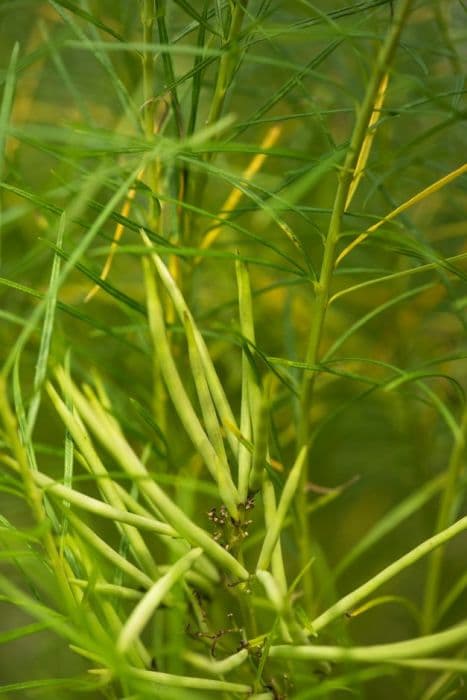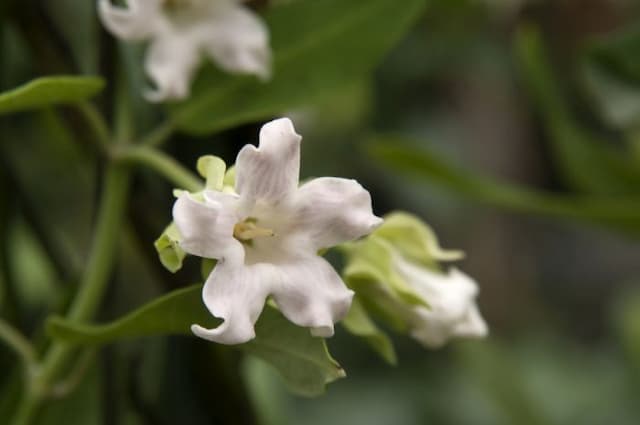Butterfly weed Asclepias tuberosa

ABOUT
The plant commonly known as butterfly weed is a colorful perennial recognized for its vibrant flowers and attractiveness to butterflies. It has a sturdy, upright growth habit with oblong leaves that are medium green in color. The leaves are arranged alternately along the stems, giving a lush appearance. The most striking feature of butterfly weed is its flowers. These flowers are small, vividly orange to yellow, and grouped into cluster-like formations known as umbels at the tops of the stems. Each individual flower is elaborate with a five-lobed corolla and a central crown-like structure that adds to the complexity of its appearance. The bloom period for butterfly weed is typically in the summer months, during which time it becomes a focal point in the garden because of its intense floral display. After the flowering period, the plant forms seed pods that are spindle-shaped and can split open when ripe, releasing numerous seeds with silky hairs that aid in wind dispersal. Butterfly weed's root system is characterized by a deep and sturdy taproot, which helps the plant to withstand drought conditions once established. This root system makes transplanting mature plants somewhat challenging. The plant's ability to attract butterflies, particularly monarchs, gives it added ecological value as it serves as a food source for the larval stages of these insects. The nectar from the flowers also attracts a variety of other pollinators, making butterfly weed a beneficial addition to any garden aimed at supporting local wildlife. Overall, butterfly weed's appearance—with its showy, clustered flowers and lush foliage—makes it a desirable choice for gardeners looking to add a pop of color and support pollinator species.
About this plant
 Names
NamesFamily
Apocynaceae.
Synonyms
Butterfly Weed, Pleurisy Root, Butterfly Milkweed, Orange Milkweed, Tuberosa, Chigger Flower.
Common names
Asclepias decumbens, Asclepias elliptica, Asclepias interior, Asclepias intermedia, Asclepias tuberculata, Asclepias undulata, Decodon tuberosus
 Toxicity
ToxicityTo humans
Butterfly Weed is generally not considered highly toxic to humans; however, it can contain compounds that may be mildly toxic if ingested in large quantities. These toxins can potentially cause gastrointestinal upset, such as nausea, vomiting, and diarrhea. It is advised that people do not consume any part of the plant due to the risk of adverse effects.
To pets
Butterfly Weed can be toxic to pets, especially to dogs and cats, if ingested. The plant contains cardenolides that can be harmful and may lead to signs of toxicity such as vomiting, diarrhea, lethargy, and in severe cases, can lead to more serious symptoms like difficulty breathing, dilated pupils, or a decreased heart rate. It is important to prevent pets from ingesting any part of the plant to avoid the risk of poisoning.
 Characteristics
CharacteristicsLife cycle
Perennials
Foliage type
Deciduous
Color of leaves
Green
Flower color
Orange
Height
2 feet (0.61 meters)
Spread
1.5 feet (0.46 meters)
Plant type
Herb
Hardiness zones
3-9
Native area
North America
Benefits
 General Benefits
General Benefits- Attracts Pollinators: Asclepias tuberosa, commonly known as Butterfly Weed, is known for attracting butterflies, including the monarch butterfly which relies on it for food during its larval stage.
- Low Maintenance: Once established, Butterfly Weed is drought tolerant and requires minimal care, making it suitable for low-maintenance gardens.
- Supports Biodiversity: By providing essential nectar for a variety of insects, Butterfly Weed contributes to maintaining and supporting local biodiversity.
- Native Plant Advantage: As a native plant in North America, it is well-adapted to local climates and soils, reducing the needs for additional water or fertilizers.
- Erosion Control: The deep root system of Butterfly Weed helps to stabilize soil and can prevent erosion, especially in sandy or well-drained locations.
- Decorative Appeal: With its vibrant orange to yellow flowers, Butterfly Weed adds striking color to gardens and can be used in a wide range of landscape designs.
- Seed Pods for Crafting: The plant's distinctive seed pods can be used in dry floral arrangements and for various crafting purposes once they mature in the fall.
 Medical Properties
Medical Properties- Expectorant – Asclepias tuberosa has been used traditionally to help expel phlegm from the respiratory tract.
- Diaphoretic – The plant is known for inducing sweating, which can be beneficial in reducing fever.
- Antispasmodic – It may help relieve muscle spasms and cramps.
- Carminative – The plant has been used to help alleviate digestive issues such as flatulence and bloating.
- Anti-inflammatory – Compounds in Asclepias tuberosa may have anti-inflammatory properties, though robust research is limited.
 Air-purifying Qualities
Air-purifying QualitiesThis plant is not specifically known for air purifying qualities.
 Other Uses
Other Uses- Monarch Butterfly Attraction: Butterfly weed is a crucial nectar source for monarch butterflies and helps sustain their populations by acting as a host plant for their larvae.
- Natural Dye: The flowers and roots of butterfly weed can be used to create natural dyes for fabrics, yielding colors ranging from green to orange, depending on the mordants used.
- Landscaping: Due to its bright orange flowers and hardiness, butterfly weed is popular for xeriscaping—landscaping that reduces or eliminates the need for supplemental water.
- Erosion Control: The deep and extensive root system of butterfly weed helps to stabilize soil and can be used to control erosion in susceptible areas.
- Companion Planting: Butterfly weed can be planted alongside vegetable crops to attract pollinators and beneficial insects, thereby enhancing pollination and decreasing harmful pests.
- Education and Conservation: Butterfly weed serves as an educational tool for teaching about plant-animal interactions, specifically the dependence of monarch butterflies on milkweed species.
- Habitat Restoration: Butterfly weed is planted in restoration projects to recreate the native prairie ecosystems where they once naturally occurred.
- Fall Interest: The seed pods of butterfly weed add visual interest to garden landscapes in the fall, with their unique shape and textural qualities.
- Floral Arrangements: Dried seed pods, as well as fresh cut flowers of butterfly weed, are both used in floral arrangements and bouquets.
- Photography Subject: Butterfly weed's vivid colors and association with butterflies make it a popular subject for nature photography, promoting awareness and appreciation for native flora.
Interesting Facts
 Feng Shui
Feng ShuiButterfly Weed is not used in Feng Shui practice.
 Zodiac Sign Compitability
Zodiac Sign CompitabilityButterfly Weed is not used in astrology practice.
 Plant Symbolism
Plant Symbolism- Hope: Often found thriving in tough environments where other plants may not survive, Asclepias tuberosa, commonly known as Butterfly Weed, is a symbol of hope and the ability to endure trying conditions.
- Transformation: Since it is a vital host plant for monarch butterflies, the Butterfly Weed represents transformation and the beauty of change, mirroring the butterfly's life cycle.
- Survival: As a hardy and resilient plant, Butterfly Weed signifies survival and adaptation, as it can grow in poor soils and harsh climates.
- Healing: Historically, the Butterfly Weed has been used in traditional medicine, making it a symbol of healing and restoration of health.
 Water
WaterThe Butterfly Weed prefers to be watered once every week with roughly 1 inch of water during the growing season. In times of extreme dryness, this may increase to twice per week. It's important to let the soil dry out somewhat between waterings, as overly moist conditions can lead to root rot. During the winter, when the plant is dormant, less watering is required; you may reduce watering to once every two or three weeks, depending on the dryness of the surrounding environment. Be cautious not to over-water, as Butterfly Weed thrives in drier conditions and is drought-tolerant once established.
 Light
LightThe Butterfly Weed thrives best in full sunlight, needing at least 6 to 8 hours of direct sunlight each day. The ideal spot for Butterfly Weed would be in an area where it can enjoy unfiltered sunlight throughout the day, as this positively impacts its blooming and growth.
 Temperature
TemperatureButterfly Weed performs well in temperatures ranging from 60 to 90 degrees Fahrenheit. It can tolerate a minimum temperature down to around 20 degrees Fahrenheit but may suffer if temperatures drop below this point. The ideal growing conditions for the Butterfly Weed are warm days with temperatures sitting comfortably between 70 and 85 degrees Fahrenheit.
 Pruning
PruningPruning Butterfly Weed mainly involves deadheading spent flowers to encourage more blooms and to maintain the plant's appearance. This can be done throughout the blooming season. After flowering, seed pods can be removed to prevent the plant from self-seeding excessively. Cutting back the plant in late autumn or early winter, after it has gone dormant, helps to keep it tidy and can stimulate robust growth in the spring.
 Cleaning
CleaningAs needed
 Soil
SoilButterfly Weed, commonly known as Asclepias tuberosa, prefers a well-draining soil mix with a pH range of 6.0 to 6.8. The ideal soil mixture could be a combination of loamy garden soil, sharp sand, and compost to ensure adequate drainage and fertility. It's essential to avoid heavy, wet soils as this plant is drought-tolerant and excessive moisture can lead to root rot.
 Repotting
RepottingButterfly Weed does not need frequent repotting as it prefers to be left undisturbed. It can typically be repotted every 2-3 years or when the plant has clearly outgrown its current container. However, care should be taken to avoid damaging the long taproot during repotting.
 Humidity & Misting
Humidity & MistingButterfly Weed thrives in average humidity conditions that are typical of its natural prairie habitat. It does not require high humidity levels, making it a suitable plant for typical outdoor conditions.
 Suitable locations
Suitable locationsIndoor
Ensure full sun and use well-draining soil.
Outdoor
Plant in full sun, well-draining soil, and minimal water.
Hardiness zone
3-9 USDA
 Life cycle
Life cycleAsclepias tuberosa, commonly known as Butterfly Weed, begins its life as a seed that requires a period of cold stratification to germinate. Upon warming temperatures in the spring, the seedlings emerge from the soil and develop into young plants with narrow leaves. As they mature, Butterfly Weed plants develop a deep taproot that helps them survive in dry conditions. Through the summer months, the plants produce vibrant orange to yellow flowers that attract pollinators, particularly butterflies, for which the plant is named. After pollination, the flowers develop into seed pods that release seeds with silk-like attachments, allowing them to be dispersed by the wind in late summer or fall. Butterfly Weed is a perennial, so after the aboveground plant parts die back in the winter, it regrows from the same root system in the following spring.
 Propogation
PropogationPropogation time
Spring to Summer
The Butterfly Weed, commonly known as Asclepias tuberosa, is propagated primarily through seed sowing. The most popular time to plant the seeds is in the fall, which allows for the natural stratification process to occur, aiding in breaking the seed dormancy. However, one can also manually stratify seeds by placing them in a moistened medium within a plastic bag and then refrigerating them for a period of 3 to 6 weeks. After stratification, seeds should be sown at a shallow depth, about 1/4 inch (approximately 0.6 cm) deep, in well-draining soil and kept consistently moist until germination, which typically occurs in 10 to 20 days. It's important to sow the seeds in a location with full sun exposure to facilitate the best growth and flowering. Once germinated, the seedlings can be gradually acclimated to outdoor conditions before being planted in their final growing spots.









